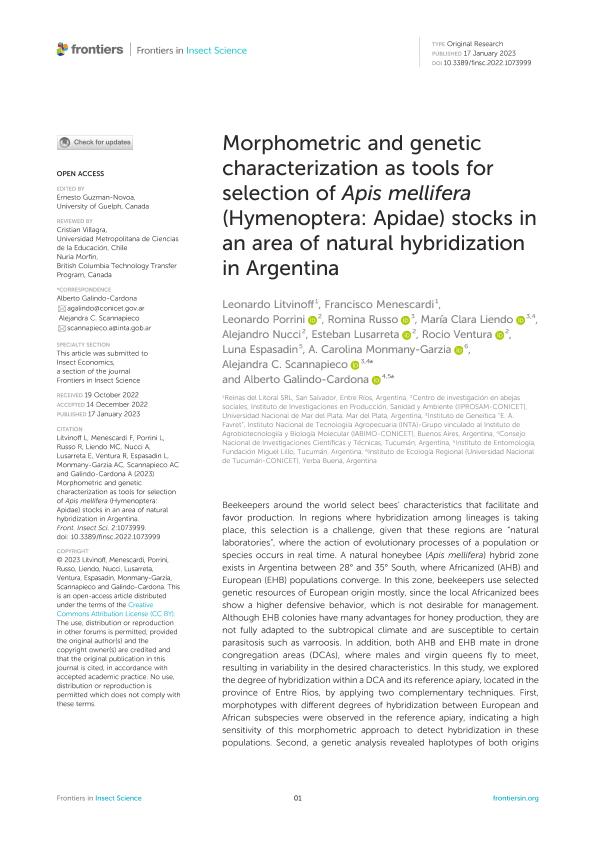Artículo
Morphometric and genetic characterization as tools for selection of Apis mellifera (Hymenoptera: Apidae) stocks in an area of natural hybridization in Argentina
Litvinoff, Leonardo; Menescardi, Francisco; Porrini, Leonardo Pablo ; Russo, Romina; Liendo, María Clara
; Russo, Romina; Liendo, María Clara ; Nucci, Alejandro; Lusarreta, Esteban; Ventura, Rocía; Espasadin, Luna; Monmany, Ana Carolina
; Nucci, Alejandro; Lusarreta, Esteban; Ventura, Rocía; Espasadin, Luna; Monmany, Ana Carolina ; Scannapieco, Alejandra Carla
; Scannapieco, Alejandra Carla ; Galindo Cardona, Alberto
; Galindo Cardona, Alberto
 ; Russo, Romina; Liendo, María Clara
; Russo, Romina; Liendo, María Clara ; Nucci, Alejandro; Lusarreta, Esteban; Ventura, Rocía; Espasadin, Luna; Monmany, Ana Carolina
; Nucci, Alejandro; Lusarreta, Esteban; Ventura, Rocía; Espasadin, Luna; Monmany, Ana Carolina ; Scannapieco, Alejandra Carla
; Scannapieco, Alejandra Carla ; Galindo Cardona, Alberto
; Galindo Cardona, Alberto
Fecha de publicación:
01/2023
Editorial:
Frontiers Media
Revista:
Frontiers in Insect Science
e-ISSN:
2673-8600
Idioma:
Inglés
Tipo de recurso:
Artículo publicado
Clasificación temática:
Resumen
Beekeepers around the world select bees’ characteristics that facilitate and favor production. In regions where hybridization among lineages is taking place, this selection is a challenge, given that these regions are “natural laboratories”, where the action of evolutionary processes of a population or species occurs in real time. A natural honeybee (Apis mellifera) hybrid zone exists in Argentina between 28° and 35° South, where Africanized (AHB) and European (EHB) populations converge. In this zone, beekeepers use selected genetic resources of European origin mostly, since the local Africanized bees show a higher defensive behavior, which is not desirable for management. Although EHB colonies have many advantages for honey production, they are not fully adapted to the subtropical climate and are susceptible to certain parasitosis such as varroosis. In addition, both AHB and EHB mate in drone congregation areas (DCAs), where males and virgin queens fly to meet, resulting in variability in the desired characteristics. In this study, we explored the degree of hybridization within a DCA and its reference apiary, located in the province of Entre Ríos, by applying two complementary techniques. First, morphotypes with different degrees of hybridization between European and African subspecies were observed in the reference apiary, indicating a high sensitivity of this morphometric approach to detect hybridization in these populations. Second, a genetic analysis revealed haplotypes of both origins for drones in DCAs, with a higher prevalence of European haplotypes, while all the colonies from the reference apiary exhibited European haplotypes. Overall, our results are in line with the strong impact that commercial beekeeping has on the genetics of DCAs. We show how wing morphometry may be used to monitor hybridization between European and African subspecies, a tool that may be evaluated in other regions of the world where hybridization occurs.
Palabras clave:
AFRICANIZATION
,
DRONE CONGREGATION AREAS
,
HONEY BEES
,
HYBRID ZONE
,
MATING
Archivos asociados
Licencia
Identificadores
Colecciones
Articulos (IABIMO)
Articulos de INSTITUTO DE AGROBIOTECNOLOGIA Y BIOLOGIA MOLECULAR
Articulos de INSTITUTO DE AGROBIOTECNOLOGIA Y BIOLOGIA MOLECULAR
Articulos (IIPROSAM)
Articulos de INSTITUTO DE INVESTIGACIONES EN PRODUCCION, SANIDAD Y AMBIENTE
Articulos de INSTITUTO DE INVESTIGACIONES EN PRODUCCION, SANIDAD Y AMBIENTE
Articulos(CCT - NOA SUR)
Articulos de CTRO.CIENTIFICO TECNOL.CONICET - NOA SUR
Articulos de CTRO.CIENTIFICO TECNOL.CONICET - NOA SUR
Articulos(CIVETAN)
Articulos de CENTRO DE INVESTIGACION VETERINARIA DE TANDIL
Articulos de CENTRO DE INVESTIGACION VETERINARIA DE TANDIL
Articulos(IER)
Articulos de INSTITUTO DE ECOLOGIA REGIONAL
Articulos de INSTITUTO DE ECOLOGIA REGIONAL
Citación
Litvinoff, Leonardo; Menescardi, Francisco ; Porrini, Leonardo Pablo; Russo, Romina; Liendo, María Clara; et al.; Morphometric and genetic characterization as tools for selection of Apis mellifera (Hymenoptera: Apidae) stocks in an area of natural hybridization in Argentina; Frontiers Media; Frontiers in Insect Science; 2; 1-2023; 1-10
Compartir
Altmétricas



